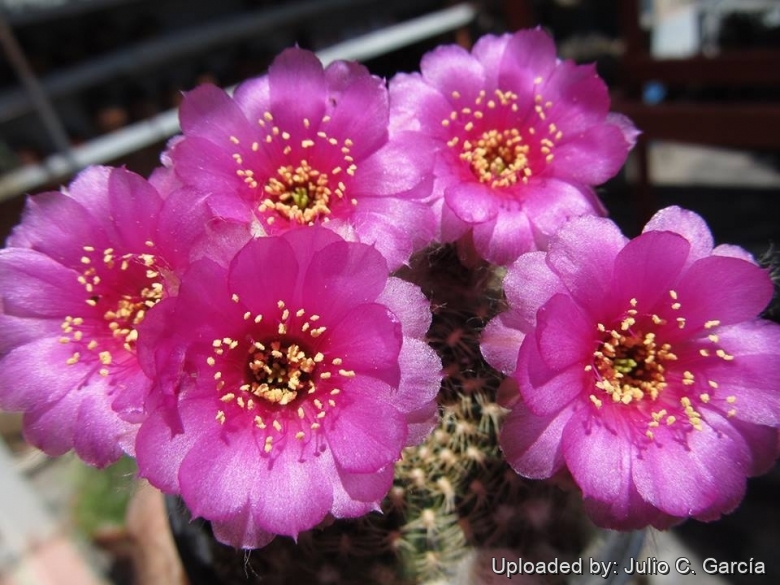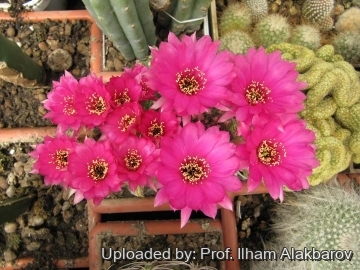Donate now to support the LLIFLE projects.
Your support is critical to our success.
Your support is critical to our success.
= Lobivia tiegeliana var. pusilla (F.Ritter) Rausch
Lobivia 2: 92. 1975
Accepted Scientific Name: Echinopsis tiegeliana (Wessner) D.R.Hunt
Bradleya 9: 88. 1991

Hymenorebutia pusilla (Lobivia tiegeliana var. pusilla) Photo by: Julio C. García
Synonyms:
- Lobivia tiegeliana var. pusilla (F.Ritter) Rausch
- Hymenorebutia pusilla (F.Ritter) F.Ritter
- Lobivia pusilla F.Ritter
See all synonyms of Echinopsis tiegeliana
back
Accepted name in llifle Database:Echinopsis tiegeliana (Wessner) D.R.Hunt
Bradleya 9: 88. 1991
Synonymy: 34
- Echinopsis tiegeliana (Wessner) D.R.Hunt
- Hymenorebutia tiegeliana (Wessner) F.Ritter
- Lobivia tiegeliana Wessner
- Echinopsis fricii (Rausch) Friedrich
- Lobivia fricii Rausch
- Lobivia tiegeliana var. fricii (Rausch) Rausch
- Echinopsis tiegeliana f. cristata hort.
- Echinopsis tiegeliana f. variegata hort.
- Lobivia pusilla f. aurea hort.
- Lobivia pusilla f. cristata hort.
- Lobivia tiegeliana f. albiflora (Krainz) Krainz
- Lobivia peclardiana var. albiflora Krainz
- Lobivia tiegeliana (Krainz) Krainz non Wessner
- Lobivia tiegeliana f. dimorphipetala (F.Ritter) J.Ullmann
- Lobivia tiegeliana var. distefanoana Cullmann & F.Ritter
- Hymenorebutia tiegeliana var. distefanoiana (Cullmann & F.Ritter) F.Ritter
- Lobivia tiegeliana var. flaviflora (F.Ritter) Rausch
- Hymenorebutia pusilla f. flaviflora (F.Ritter) F.Ritter
- Lobivia pusilla f. flaviflora F.Ritter
- Lobivia tiegeliana var. peclardiana (Krainz) Krainz
- Lobivia peclardiana Krainz
- Lobivia tiegeliana var. pusilla (F.Ritter) Rausch
- Hymenorebutia pusilla (F.Ritter) F.Ritter
- Lobivia pusilla F.Ritter
- Lobivia tiegeliana var. ruberrima Rausch
- Hymenorebutia tiegeliana var. ruberrima (Rausch) F.Ritter
- Lobivia tiegeliana var. uriondoensis Rausch
- Lobivia tiegeliana Rausch non Wessner
- Lobivia tiegeliana f. winteriae (Krainz) Krainz
- Mediolobivia hirsutissima Cárdenas
back

Hymenorebutia pusilla (Lobivia tiegeliana var. pusilla) Photo by: Valentino Vallicelli

Hymenorebutia pusilla (Lobivia tiegeliana var. pusilla) Photo by: Prof. Ilham Alakbarov

Hymenorebutia pusilla (Lobivia tiegeliana var. pusilla) Photo by: Carolina González

Hymenorebutia pusilla (Lobivia tiegeliana var. pusilla) Photo by: Carolina González

Hymenorebutia pusilla (Lobivia tiegeliana var. pusilla) Photo by: Prof. Ilham Alakbarov
Send a photo of this plant.
The gallery now contains thousands of pictures, however it is possible to do even more. We are, of course, seeking photos of species not yet shown in the gallery but not only that, we are also looking for better pictures than those already present. Read More...
The gallery now contains thousands of pictures, however it is possible to do even more. We are, of course, seeking photos of species not yet shown in the gallery but not only that, we are also looking for better pictures than those already present. Read More...
| Your Actions | |
|---|---|
| Back to Hymenorebutia index | |
| Back to Cactaceae index | |
 |
Back to Cacti Encyclopedia index |









